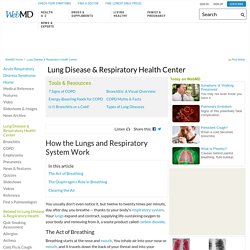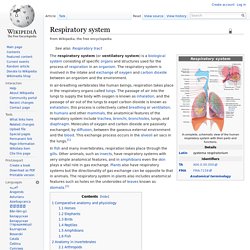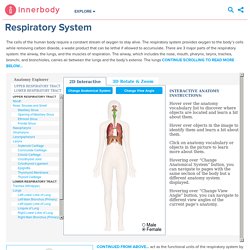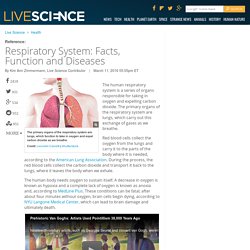

What is the function of the respiratory system? The respiratory system is the group of tissues and organs in your body that enable you to breathe.

This system includes your airways, your lungs and the blood vessels and muscles attached to them that work together so you can breathe. The respiratory system's primary function is to supply oxygen to all the parts of your body. It accomplishes this through breathing: inhaling oxygen-rich air and exhaling air filled with carbon dioxide, which is a waste gas. The respiratory system is made up of airways (your nose, mouth, voice box, windpipe and bronchial tubes) and the lungs and the muscles and blood vessels connected to them. This is how the respiratory system works: First you breathe air in through your nose and mouth, which wet and warm the air so it won't irritate your lungs. 5 Functions of Respiratory System.
Human Respiratory System and Lungs; How They Work. You usually don't even notice it, but twelve to twenty times per minute, day after day, you breathe -- thanks to your body's respiratory system.

Your lungs expand and contract, supplying life-sustaining oxygen to your body and removing from it, a waste product called carbon dioxide. The Act of Breathing Breathing starts at the nose and mouth. You inhale air into your nose or mouth, and it travels down the back of your throat and into your windpipe, or trachea. The Respiratory System. Respiratory System - Anatomy and Physiology. Your Lungs & Respiratory System. Your lungs work with your respiratory system to allow you to take in fresh air, get rid of stale air, and even talk. Let's take a tour of the lungs! Locate Those Lungs. Respiratory system. In fish and many invertebrates, respiration takes place through the gills.

Other animals, such as insects, have respiratory systems with very simple anatomical features, and in amphibians even the skin plays a vital role in gas exchange. Plants also have respiratory systems but the directionality of gas exchange can be opposite to that in animals. Interactive Anatomy Guide. The cells of the human body require a constant stream of oxygen to stay alive.

The respiratory system provides oxygen to the body’s cells while removing carbon dioxide, a waste product that can be lethal if allowed to accumulate. There are 3 major parts of the respiratory system: the airway, the lungs, and the muscles of respiration. The airway, which includes the nose, mouth, pharynx, larynx, trachea, bronchi, and bronchioles, carries air between the lungs and the body’s exterior. The lungs Continue Scrolling To Read More Below... Why do we need the respiratory system? The lungs and heart work together to ensure that every cell in the body acquires enough oxygen to function properly.

Delivery of oxygen to the blood through breathing is the primary function of the respiratory system. Moreover, the respiratory system expels carbon dioxide, which is a harmful waste product of cells. This gas is dangerous when it builds up in the body. Respiratory System: Facts, Function and Diseases. The human respiratory system is a series of organs responsible for taking in oxygen and expelling carbon dioxide.

The primary organs of the respiratory system are lungs, which carry out this exchange of gases as we breathe. Red blood cells collect the oxygen from the lungs and carry it to the parts of the body where it is needed, according to the American Lung Association. During the process, the red blood cells collect the carbon dioxide and transport it back to the lungs, where it leaves the body when we exhale. The human body needs oxygen to sustain itself. A decrease in oxygen is known as hypoxia and a complete lack of oxygen is known as anoxia and, according to MedLine Plus. The Lungs (Human Anatomy): Picture, Function, Definition, Conditions. The lungs are a pair of spongy, air-filled organs located on either side of the chest (thorax).

The trachea (windpipe) conducts inhaled air into the lungs through its tubular branches, called bronchi. The bronchi then divide into smaller and smaller branches (bronchioles), finally becoming microscopic. The bronchioles eventually end in clusters of microscopic air sacs called alveoli. In the alveoli, oxygen from the air is absorbed into the blood. Carbon dioxide, a waste product of metabolism, travels from the blood to the alveoli, where it can be exhaled. Epithelial Tissue : Anatomy & Physiology. Epithelial tissue is a sheet of cells that covers a body surface or lines a body cavity.

Two forms occur in the human body: Covering and lining epithelium– forms the outer layer of the skin; lines open cavities of the digestive and respiratory systems; covers the walls of organs of the closed ventral body cavity.Glandular epithelium– surrounds glands within the body.Characteristics of epithelium. Pseudostratified Columnar Epithelium: Location & Function. Anatomy and Physiology: The Relationships of the Respiratory System. Place your hand over your chest, take a deep breath, and then let it out.

Of course you already know that your lungs fill with air when you breathe, but did you know that your respiratory system does more than simply move oxygen into and out of your lungs? The structures of the respiratory system interact with structures of the skeletal, circulatory, and muscular systems to help you smell, speak, and move oxygen into your bloodstream and waste out of it. We're going to take a look at the relationships between these systems and how they work to keep you breathing 24/7/365.